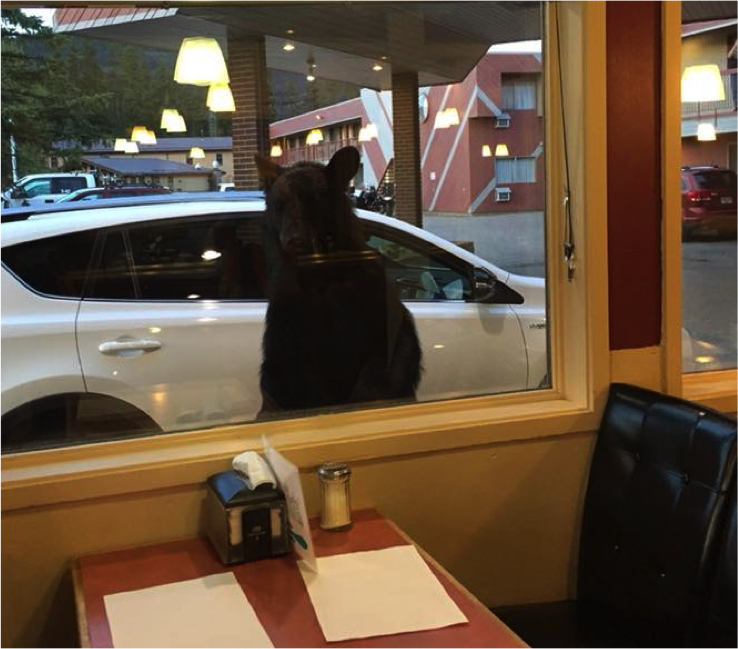
There were fewer reports of grizzly bear around Tumbler Ridge in 2018, but dramatically more black bear sightings, according to an end-of-year report by 2018 WildSafe BC coordinator Rebecca Robertson.
WildSafeBC has been in Tumbler Ridge for three years, working to provide education to residents town. Robertson says the goal of the program is “reducing the occurrence of human-wildlife conflict within the District, and fulfilling WildSafeBC’s mission of ‘keeping wildlife wild and communities safe.’”
One of the big pushes has been to encourage people to report wildlife sightings. This year, says Robertson, there were only two reported sightings of Grizzly Bear in and around the community, compared to 34 the year before and 28 in 2016.
Black bears, on the other hand, were much more commonly reported, with 79 reports in 2018, compared with 16 in 2017 and 55 in 2016. Most of these sightings, she says, were in July.
The reports are available for viewing through the Wildlife Alert Reporting Program (WARP) on the WildSafeBC website.
Robertson suggests that the increase in black bear reporting may be a result of more public understanding of reporting wildlife activity, but, she says, there was also a lot of black bear activity in the town in July. “This bear activity was not consistent with patterns in previous years,” she says, “which made it hard to predict where and when to best focus educational efforts and resources.”
Over 80 percent of the bear sighting reports in Tumbler Ridge were made in the first few weeks of July alone, says Robertson. “Unfortunately this situation escalated quickly and ultimately three male black bears displaying food-conditioned behaviour had to be destroyed by the COS within the period of a single week for the purpose of public safety.”
These events can be discouraging. However, she says, it can also be used as a learning experience, and can be used “as a motivator to remind residents that vigilance through all periods of bear activity is essential – not just the traditionally high-conflict months of August and September.”
WildSafeBC Provincial Coordinator Frank Ritcey and the BC Provincial Government Wildlife Conflict Manager Micheal Badry visited Tumbler Ridge in 2018 to discuss the Bear Smart Community Program. Robertson says they were impressed with the existing bylaws, infrastructure, and community resolve to reduce human-wildlife conflict. “Their observations led them to recommend pursuing Bear Smart Community status as a way to bolster Tumbler Ridge’s reputation within the province and beyond,” says Robertson. “It would be an exciting project to pursue in 2019 as part of WildSafeBC’s continued mandate in Tumbler Ridge.”
However, a community forum in early September on the topic of reducing human/wildlife conflict only saw three community members. Robertson believes that if it had been held in July, when bear sightings were above average, it would have generated more buzz, and more people would have come out. “It seems likely that if there had been a large amount of bear activity and human-wildlife conflict in the weeks preceding this event there would have been greater attendance numbers and social ‘buzz’ surrounding the topics discussed,” she says. “In the future it may be useful to prepare event material beforehand so that when there is a call for action and discussion in the midst of crisis an event could plausibly be organized on short notice.”
In addition to the forum, Robertson worked to educate the public. When several people reported seeing a cougar in Chamberlain Park in June, she delivered brochures to homes in the area. When ravens began digging into compost in August, she distributed information about fruit tree and attractant management.
Probably the campaign that got people talking (usually quite loudly) was the garbage tagging campaign. With the help of a volunteer, says Robertson, garbage tagging was conducted three different times this year for the entire town.
“In total, approximately 120 stickers were placed on garbage bins put out the night before collection,” she says. “Fortunately the vast majority of residents are putting their garbage out at the right time and remembering to use the clips on the new bins. However, further education is required to help residents understand the new bins are ‘bear resistant’ not ‘bear proof’ and why it is important to secure bins during the week to prevent access by bears.
Robertson also showed up to many events in town to provide information about wildlife and how to reduce conflicts, including the Emperor’s Challenge, where she gave instructions to participants on the proper use of bear spray.
Trent is the publisher of Tumbler RidgeLines.

